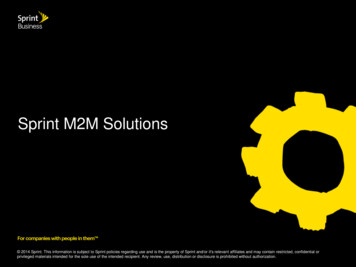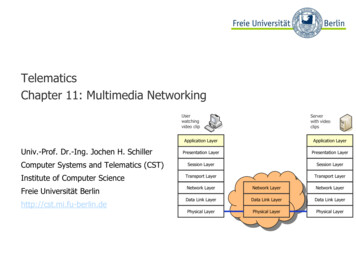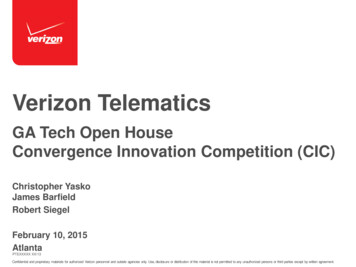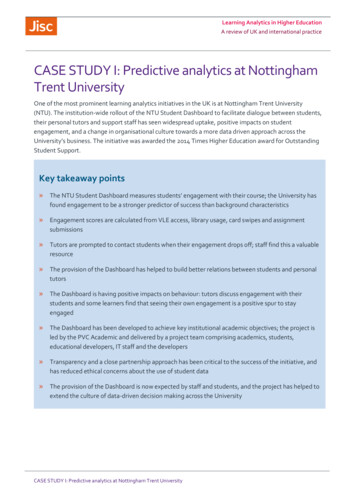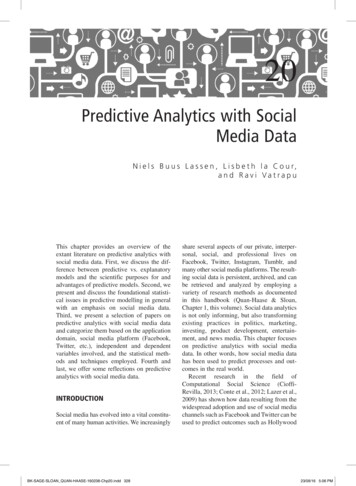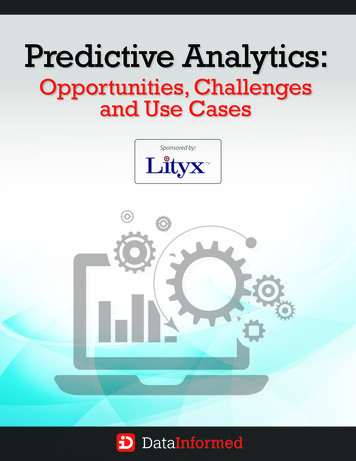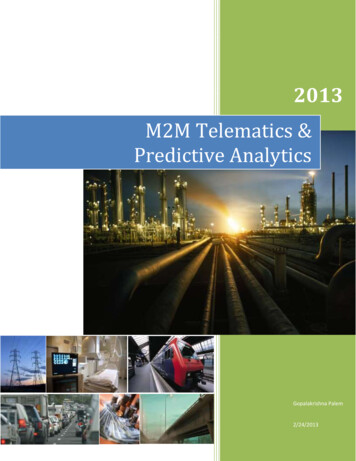
Transcription
2013M2M Telematics &Predictive AnalyticsGopalakrishna Palem2/24/2013
C ONTENTSExecutive Summary .2M2M Drivers .4Embedded Telematics Trends .4Mobile Device Telematics Trends .5Predictive Maintenance .7Solution Enablers .9The Methodology .11Best Practices Guidelines .15Concluding Remarks .16References .16About Author .17
E XECUTIVE S UMMARYNumber of machine-to-machine (M2M) device connections world-wide is expected togrow from 130 million in 2012 to 2.14 billion by 2021, while the total world-wide M2Mmanagement market is expected to grow from USD459 million in 2012 to USD1.1 billionin 2016 at 23% CAGR (Figure 1).12001118Revenue (USD Million)100089580072457460045939740020002011F IGURE 1 M2M20122013201420152016MANAGEMENT MARKET FORECAST ( S O URCE : A NA LYSYS M ASON , 2012 )CSPs are actively exploring opportunities for providing M2M solutions to industrysectors such as automotive and transport, energy and utilities, security and surveillance,public safety, financial services, retail, healthcare, and warehousing and distribution. Automotive:o Vehicle & Asset Tracking: Real-time GPS/GSM evaluation and trackingo Fleet management: Real-time predictive maintenance, inventorycontrol, optimal work-scheduleso Eco-routing: Real-time traffic monitoring systems for vehicle efficiencyand passenger safety with cooperative M2M interactionsHealthcare:o Telemedicine: Health monitoring and remote medicine administrationo Assisted Living: Supportive sensor aids and safety guidesRetail:o Match sales: Real-time auctioning for buyer’s basketo Supply chain monitoring: Real-time environment conditions of goods,location trackingo Connected cabinets: Real-time stock level display, revenue reports,targeted advertisingFinance:o Usage-based Insurance ServicesEnergy & Utilities:
ooSmart Grid: Real-time network optimization with demand basedgeneration, load-based distribution and smart metering capabilitiesMonitoring & Control: Remote monitoring operational metrics, such aspipeline pressure, temperature etc.As the global energy usage continues to surge, the confluence of M2M telematics andreal-time analytics is the key for delivering green solutions.Take an example of electric vehicle (EV) that you drive home and connect to the electricgrid, letting it figure out your next commute requirement from the calendarappointments on your hand-held or mobile, and your grid’s active load usage and nonpeak hours from the energy provider, all summed up to auto-tune its own rechargingschedule to reduce the load on grid while taking into account any emergency commutesthat might be required based on your personal commute history and your associations –computed all without the need for slightest manual intervention, that’s M2M Telematicshand-in-hand with real-time analytics at work.Intelligent devices, such as the EV presented above, are the promise of M2M. On abroader note, the machine-to-machine (M2M) communication operations include both,intelligent control of remote machine parts (telematics) and remote measurement ofvarious sensor readings (telemetry). A typical definition of M2M in mobile space is,machines using network resources to communicate with remote applicationinfrastructure for monitoring and control, either of the machine itself or its surroundingenvironment.The possibility of having billions of devices being uniquely addressable with IPV6(Internet Protocol version 6), the advent of seamless wireless communications withimproved standardization and broadband signal capabilities, and the onslaught of realtime analytics on commodity hardware with large data sets being processed in parallel –all are contributing to the success of M2M telematics systems with real-time predictiveanalytic capabilities. A typical architecture of such a system reads as shown in Figure 2.AnalyticsProcessingStream ProcessingRemoteAdministrationExternalSensorsAsset with InternalSensorsMonitor & Control CenterF IGURE 2 M2M T ELEMATICS WITH P REDICTIVE A NALYTICS S YSTEM
M2M D R I V E R SKey drivers for M2M initiatives are as below: Telematics and telemetry are increasingly being perceived as sources of greateroperational efficiency and cost reduction.o Automated monitoring of heating, ventilation and cooling are fewdriving factors for smart buildingso Street lights that operate based on traffic flow, alternate automaticrouting based on peak-hours etc. are driving factors for smart citieso Predictive maintenance through improved system monitoring, remotemonitoring of farms and mining operations etc. are cost saving factorsRegulatory requirements for safety and energy efficiency are pushing the utilitysector and automotive industries to use innovative ways of M2M methodso Emergency calling, accident alerts, cooperative driving etc. arecompelling factors for automotive industryo Smart meters and energy demand response are driving factors forUtilities industryStandardization and adaptation of IPV6 across industry has opened thepossibility for billions of uniquely addressable IP devicesWide rollout of 3G and LTE networks are providing devices with always onconnectivity and increased bandwidth enabling M2M segment applicationssuch as remote surveillance, asset tracker, health meters etc.Smart application development is creating new opportunities for applicationdevelopers to build applications for every possible segment, right from smarthomes to smart amenitiesInnovations in the retail and consumer electronics segment are pushing theboundaries of connectivity, with applications such as wireless payments toconnected satellite navigation systemsThe electronics and communications industry is rapidly moving towards intelligent,addressable, embeddable devices enabling seamless communications between everydevice. Following sections describe the embedded and mobile based telematics trendsand the potential revenue opportunities, followed by a sector-focus case study.E MB E D D ED T EL E M AT I C S T RE N D S2.5G GPRS-3G CDMA3.5G HSPA-4G LTEKey InformationDominant embeddedtechnology in EuropeCDMA2000 is dominant inUSAEurope is moving to WCDMANew systems are evolvingrapidly on HSPAIndustry wide deploymentsare expected to be availableby 2015-RemarksNew systems should beusing 3GAlso used in Japan, Koreaand ChinaeCall may use either GPRSor WCDMAAvailable in Europe forLuxury carsMay be year earlier forLuxury brands
In summary, embedded telematics are likely to continue using 3G and 3.5G technologiesuntil 2015 in the developed countries, and even longer in other areas. LTE is expected tobecome mainstream 4G technology for mobile phone industry and auto-industry.WiMax missed its opportunity to become mainstream technology, but will become aniche player in most regions.M O BI LE D EV I CE T EL E M AT I CS T R EN D SMobile device telematics leverage operator’s mobile phone to establish communicationbetween instrument and the monitoring station. Predominantly used in vehicles andautomobiles, driven by the need for hands-free interface (HFI). The trends are:Key InformationMobilePhone HFITelematicsService-Available for long time by OEMs-Evolving as a popular telematicsapproachPrimarily for infotainmentservices--TelematicsService &SmartphoneApps-Leverage wealth of auto-relatedsmart AppsSmart phone to H-U appsintegration emerging-RemarksInitially wired, thenBluetoothPopularized by FordSYNC successLower reliability thanembedded linkLikely to becomenecessity by 2015timeframeNeed for technologysolutions to lowerdriver distractionSome of the prominent market implementations for automobile telematics in NorthAmerica segment nnectDrive /BMW AssistFordSync/ MyFordTouch / MyFordMobileToyotaSafety Connect /EntuneAudiAudi ConnectMercedesmBraceNissanNissan CarWingsHyundaiBlue LinkFeatureseCall/bCall, SVR, VehicleSlow Down, Google, MobileAppeCall/bCall, Concierge,Lock/Unlock, Diagnostics,Google Services, Tracking,Full Browsing, Mobile Apps,TrafficeCall/bCall, Navigation,Weather, Traffic, MobileApps, Live OperatorSOS/ACN, RoadsideAssistance, Stolen VehicleLocation, EntuneNavigation, Weather, Gasprices, Travel Info, News,Wi-Fi HotspoteCall/bCall, SVR, Crisis Assist,Google Send to Car, Traffic,Weather, Concierge,Lock/Unlock, Car Finder,Diagnostics, Mobile AppCharge Levels, ChargingStations, Comparison ofDrivers, Google Send to CarNavi, eCall/bCall, 11Embedded2011Embedded
Traffic, POI Voice Rec, GeoFence, SVR, Diagnostics,Mobile AppDespite the present and emerging mobile connectivity trend, embedded wirelessmodules are expected to grow significantly, mainly due to the stringent qualityrequirements and reliability standards that hand-held devices fail to meet adequately.Tight automotive requirements are also expected to be in place to sustain the growth ofsafety and security critical equipment that will be mandated by government regulations,such as eCall in Europe. The European eCall regulations will in fact force all new vehiclesby 2015 to adapt a connectivity link for emergency call.The reality is that regulations such as eCall will give raise to further significant demandfor telematics, enabling several additional services to be layered on top of basicemergency call. Some of the potential applications on those lines are: Remote DiagnosticsRemote Vehicle ControlVehicle Software UpgradeElectronic Toll CollectionEco-DrivingOff-Board NavigationSmart Traffic ControlUsage-based Insurance ServicesCondition-based Maintenance etc.It is the combination of Telematics with Predictive Analytics on Real-time Big Data thatmakes many of these innovations, such as smart traffic control, usage-based insurance,condition-based maintenance etc possible, and smart players are already reapingenormous benefits by employing these in their strategic offerings.The following sections present an in-depth review on a sector-focus case-study, namelyCondition-based maintenance, describing how predictive analytics and telematics areworking together to reduce maintenance costs.
P REDICTIVE M AINTENANCEMaintenance, considered as a non-value add function, is ever more requestedto contribute higher and higher for costs reduction, keeping the machines inexcellent working condition, while satisfying the stringent safety andoperational requirements. Manufacturers and operators employ array of maintenancestrategies to address that, all of which can be broadly categorized as below: Corrective MaintenancePreventive MaintenancePredictive MaintenanceCorrective maintenance is the classic Run-to-Failure reactive maintenance that has nospecial maintenance plan in place. The machine is assumed to be fit unless provenotherwise. “ In many cases,scheduled overhaulincreases the overallfailure rate byintroducing a highinfant mortality rateinto an otherwisestable system ”-RCM Guide, NASA Cons:oooPros:ooHigh risk of collateral damage and secondary failureHigh production downtimeOvertime labor and high cost of spare partsMachines are not over-maintainedNo overhead of condition monitoring or planning costsPreventive maintenance (PM) is the popular periodic maintenance strategy that isactively employed by all manufacturers and operators in the industry today. An optimalbreakdown window is pre-calculated (at the time of component design or installation,based on a wide range of models describing the degradation process of equipment, coststructure and admissible maintenance etc.), and a preventive maintenance schedule islaid out. Maintenance is carried-out on those periodic intervals, assuming that themachine is going to break otherwise. Cons:ooPros:oooCalendar-based maintenance: Machines are repaired when there areno faultsThere will still be unscheduled breakdownsFewer catastrophic failures and lesser collateral damageGreater control over spare-parts and inventoryMaintenance is performed in controlled manner, with a roughestimate of costs well-known ahead of timePredictive Maintenance (PdM) is an emerging alternative to the above two that employspredictive analytics over real-time data collected (streamed) from parts of the machineto a centralized processor that detects variations in the functional parameters anddetects anomalies that can potentially lead to breakdowns. The real-time nature of theanalytics helps identify the functional breakdowns long before they happen but soonafter their potential cause arises.
“ Preventivemaintenance is howfleets attempt toavoid breakdownstoday. But newthinking is movingtowards predictiverepairs, transformingtime-or mileagebased model with onethat is based onevidence of need ” Pros:oooCons:ooUnexpected breakdown is reduced or even completely eliminatedParts are ordered when needed and maintenance performed whenconvenientEquipment life is maximizedHigh investment costsAdditional skills might be requiredPredictive maintenance, also known as Condition Based Maintenance (CBM) differsfrom preventive maintenance by basing maintenance need on the actual condition ofthe machine rather than on some preset schedule.For example, a typical preventive maintenance strategy demands automobile operatorsto change the engine oil after every 3,000 to 5,000 Miles traveled. No concern is givento the actual condition of vehicle or performance capability of the oil.If on the other hand, the operator has some way of knowing or somehow measuring theactual condition of the vehicle and the oil lubrication properties, he/she gains thepotential to extend the vehicle usage and postpone oil change until the vehicle hastraveled 10,000 Miles, or perhaps pre-pone the oil change in case of any abnormality.Predictive analytics with M2M telematics provides such deep insights into the machineoperations and full functionality status – giving rise to optimal maintenance scheduleswith improved machine availability.Underlying preventive maintenance is the popular belief that machine failures aredirectly related to machine operating age, which studies indicate not to be true always.Failures are not always linear in nature. Studies indicate that 89% of the problems arerandom with no direct relation to the age. Table 1 showcases some of these well-knownfailure patterns and their conditional probability (Y-axis) with respect to Time (X-axis).T ABLE 1 F AILURE C ONDITIONAL P ROBABILITY C URVES ( SOUR CE : J OHN M OUBRAY , N OWLAN & H EAP )Age-Related 11%Random 89%Wear outInfant MortalityType A 2%Type B 68%BathtubType E 4%Initial Break-in PeriodType C 7%FatigueRelatively ConstantType F 5%Type D 14%
“Predictive analyticshelp reduce overmaintenance,decrease operationalcosts and maximizeequipmentavailability”Complex items frequently demonstrate some infant mortality, after which their failureprobability either increases gradually or remains constant, and a marked wear-out age isnot common. Considering this fact, the chance of a preventive maintenance avoiding apotential failure is low, as there is every possibility that the system can fail right after ascheduled maintenance. Thus, preventive maintenance imposes additional costs ofrepair. Predictive Maintenance reduces such additional costs by schedulingmaintenance if and only when a potential breakdown symptom is identified.Preventive MaintenancePredictive MaintenanceF IGURE 3 P REDICTIVE MAINTENANC E S CHEDULES ARE SMARTERAND CONVENIENTHowever, the costs of monitoring equipment and monitoring operations should notexceed the original asset replacement costs; lest the whole point of PredictiveMaintenance becomes moot. Studies have estimated that a properly functioning CBMprogram can provide savings of 8% to 12% over the traditional maintenance schemes.Independent surveys indicate the following industrial average savings resultant frominitiation of a functional predictive maintenance program: Reduction in maintenance costs: 25% to 30%Elimination of breakdowns: 70% to 75%Reduction in equipment or process downtime: 35% to 45%Increase in production: 20% to 25%Apart from the above, improved worker and environment safety, increased componentavailability, better product quality etc. are making more and more manufacturers andoperators embrace CBM based management solutions.S OLUTION E N ABLERSPredictive Maintenance or Condition-Based-Maintenance Management (CBMM) solutionis enabled by three major technology enhancements over a traditional maintenanceschedule:1.2.3.Remote Sensor Monitoring & Data CapturingReal-time Stream Processing of Sensor DataPredictive Analytics
“ Predictivetechnology does notavoid failures – ratherwhat it avoids is thehigh-costs associatedwith the failures, byproviding earlywarnings of thefailures so thatoperators can decidewhen and where toaddress them beforethey actually happen”CBMM solutions essentially operate by having sensors attached to remote assets(mobile or stationary) that send continuous streams of data about the assets’operational conditions to a monitoring station that then analyzes them in real-timeusing predictive analytic models and detects any problems in the behavior or state ofthe asset. Once a problem is detected, appropriate pre-configured action is taken tonotify the operator or manufacture for corrective action. The monitoring station inquestion can be on the same network as that of the sensors or it could be in a remotelocation far away from them, connected through wide area networks or satellitenetworks.Nature of the sensors being monitored, frequency of the data getting collected andprecision of the analytic models being used – all affect the quality of the predictionresults. Thus, it is imperative that manufacturers and operators define all theseparameters with utmost care while deploying a condition-based-maintenancemanagement system. This, however, entails a thorough understanding of the systemunder operation and expects a clear-cut answer as to what is being monitored and whatis expected out of such monitoring. Some of the questions that can help manufacturersand operators along those lines are:For monitoring: Which parts of the system or asset are expected to be monitored?What type of data is expected to be collected and which type of sensors givesuch data? For example, visual data, thermal data etc.What is the expected frequency for the data c
Mercedes mBrace eCall/bCall, SVR, Crisis Assist, Google Send to Car, Traffic, Weather, Concierge, Lock/Unlock, Car Finder, Diagnostics, Mobile App 2011 Embedded Nissan Nissan CarWings Charge Levels, Charging Stations
